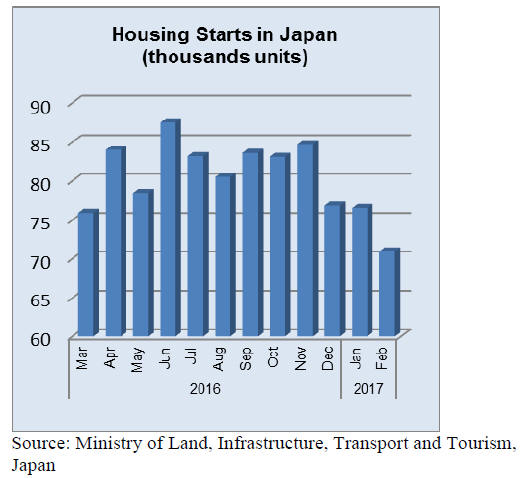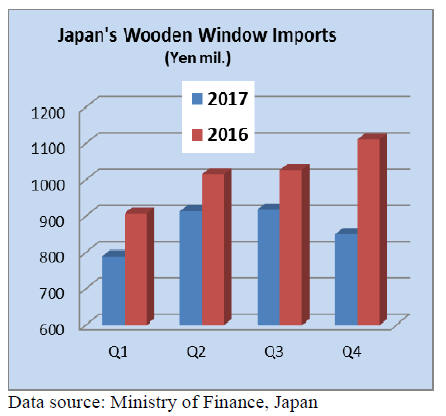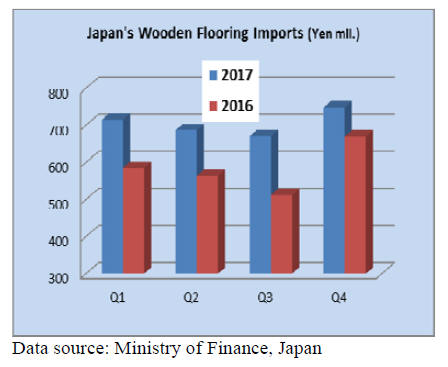Japan
Wood Products Prices
Dollar Exchange Rates of 25th
February
2018
Japan Yen 106.98
Reports From Japan
Growth hits a wall
Japan¡¯s economy has grown for eight consecutive
quarters, the best performance since a period between
1986 and 1989 during the ¡®bubble economy¡¯.
But now growth has hit a wall, the combination of much
slower growth in two years and the stronger yen in more
than twelve months is underlining how difficult it is to
revive inflation in Japan, even when other countries are
seeing improvements.
Despite this setback, a short term phenomena according to
the Bank of Japan, the government is maintaining the view
that steadily expanding industrial output and increased
capital expenditure will serve to correct any downturn.
The biggest problem is in the labour market where
shortages are emerging but not translating into higher
wages as yet. Only when this happens will a solid
foundation for inflation be established.
Exports support economy but growth at risk from
strengthening yen
The latest data on Japan¡¯s core machinery orders shows a
decline in December. Core machinery orders are regarded
as an indicator of capital investment and in a recent
government survey it was found that companies expect
orders to rise only marginally in the first quarter of this
year which risks undoing the recent improvements in
spending.
While the yen is competitive against other currencies it is
exports that are supporting economic expansion not
consumer spending.

Yen volatility of growing concern
From ending 2017 at 112/US$ the yen had strengthened by
around 5% by the end of February to around 106/US$. The
abrupt volatility in the yen dollar exchange rate has been
put down to three main converging factors, expectations
that the Bank of Japan (BoJ) will begin to unwind its
monetary easing policy, pessimism on the US dollar and
demand driven by traders looking for a safe haven in the
yen.
The Japanese government does not want to see the yen
strengthen and this played a role in the decision to
reappoint the Governor of the BoJ and at the same time
introduced a new deputy who has a reputation for bolder
views on monetary easing.
A government spokesperson is quoted as saying ¡°We
(Japan) agreed at the Group of Seven and the Group of 20
that excessive foreign exchange moves are undesirable
because they can harm the economy. Foreign exchange
stability is extremely important.¡±

Bad winter weather and slower bank lending
eats into
housing starts
Housing starts have been falling since the end of 2016 and
while the bad winter weather has disrupted building
activity more than usual there does seem to be a correction
underway.
Data is showing that real estate financing rates have fallen
with 2017 seeing an over 5% decline. Analysts put this
down largely to the decision by banks in Japan to cut back
on easy term lending rates for apartment construction.

Import round up
Doors
The value of Japan¡¯s 2017 imports of wooden doors
dropped 4% compared to a year earlier. Imports in 2017
started from a low point in the first quarter but expanded
throughout the year in contrast to the rather stable value of
quarterly imports in 2016. It remains to be seen how the
cooling of the buy-to-rent market in Japan which created a
rise in renovation expenditure impacts door imports.

December door imports
December imports of wooden doors (HS441820) reflect a
correction from the high in November dropping around
3%. Year on year Japan¡¯s wooden door imports were up
17% driven largely by the expansion of home renovation
activity.
Shippers in China continue to dominate imports of
wooden doors and in December expanded market share to
around 60%. The other main suppliers in order of rank
were the Philippines (18%), Indonesia (8%) and Malaysia
(5%).
Window imports
2017 saw a sharp drop in the value of Japan¡¯s wooden
window imports (-15%) compared to levels in 2016. The
decline in imports was in each quarter, the decline became
even more apparent in the final quarter of 2017.

December window imports
Month on month, the value of Japan¡¯s wooden window
imports were down around 3%.
The top supplier of wooden windows to Japan in
December was China which accounted for 40% of all
wooden window imports. Other suppliers were the US
(24%), the Philippines (20%) and Sweden (8%). Put
together, shippers in Europe accounted for just over 13%
of the value of Japan¡¯s wooden window imports.
Assembled flooring
The value of Japan¡¯s 2017 wooden flooring (HS441871-
79) imports was up sharply from levels in 2016, rising
over 20%. For each quarter of 2017 imports topped those
in 2016 and import values in the final quarter of 2107 were
at a multi-year high.

December imports
As in previous months wooden flooring imports were
dominated by HS 441875 which accounted for 80% of all
wooden flooring imports. HS 441879 accounted for 16%
of imports followed by HS441874 at 3%.
Shippers in China, SE Asia accounted for most of the HS
441875 shipped to Japan while Indonesia and Thailand
joined China as the main suppliers of HS441879.
Plywood
Japan¡¯s plywood imports in 2017 at almost 250,000 cu.m
were 4% higher than in 2016. Year on year shipments
from China were down 3%, Indonesian shipments were
down 5% which left Malayia accounting for the rise in
2017 imports. Shipments from Malaysia were up around
9.5% year on year.
The surge in first quarter 2017 imports was due to the high
volumes arriving in Japan from Malaysia and Indonesia
however the level of shipments slpiped in subsequent
quarters. Over 85% of 2017 plywood imports into Japan
comprised HS 441231 with a further 8% being HS
441234.

Dember plywood imports
Year on year, Japan¡¯s December 2017 plywood import
volumes were flat but month on month there was an over
20% decline in the vloume of imports with bot Malaysia
and Indonesai seeing shipments drop. This year end
decline in arrivals of plywood is usual as building activity
slows due to the winter weather which in 2017 was
particularly harsh.

Trade news from the Japan Lumber Reports (JLR)
For the JLR report please see:
http://www.nmokuzai.
com/modules/general/index.php?id=7
Local cedar for eaves of the National Olympic Stadium
The Japan Sport Council announced that wood from
7refectures in Japan will be used for eaves of the New
National Stadium for the Olympic Games in 2020. As
prayer for the East Japan Earthquake and Kumamoto
earthquake, wood from damaged prefectures will be used
for entrance gate.
Concept of the new stadium is that it is pride to the world
with utilization of domestic wood. Material is forest
certified cedar from 47 prefectures. Cedar is cut into 105
mm by 30 mm with the quality of not clear but of small
knots.
The eaves surround the stadium with 360 degrees and
wood from each prefecture is placed in the direction of the
prefecture. For instance, wood from Hokkaido and the
North East will be placed on the North side of the stadium.
The volume of the wood is 143 cubic meters in total so
each prefecture puts up 1.5 ¨C 3.0 cubic meters.
Roof construction will start in February and be completed
in November of 2019. Plan is to use the wood from the
same prefecture in case of replacement or repair in future.
China approves use of Japanese species for housing
The China Wood Structural Design Standard will be
revised in August to allow use of Japanese species of
cedar, cypress and larch for post and beam construction in
China. Discussion has been held for more than seven years
between the Wood Export Promotion Association of Japan
(WEPA) and the Housing Construction department of
China for use of Japanese wood for Chinese wooden
housing.
WEPA stipulates cedar, cypress and larch lumber as
structural material so that they can be used to build
Japanese style post and beam construction in China. With
the revision, Japan now is able to export value added
precut lumber for China market.
WEPA has been eagerly promoting Japanese wood for
housing and built model house, held seminar and manual
of wooden house building in China. There is no accurate
statistics for housing starts in China but according to
WEPA¡¯s estimate, annual starts in urban area is Chinese
gives high evaluation to the Japanese style expose use of
wood but for actual construction, it is necessary to train
Chinese architects for design and carpenters for
construction. Canada¡¯s 2x4 housing was authorized back
in 1998.
Plywood
Softwood plywood demand is easing but precutting plants
are asking delivery of delayed production. Normally the
movement slows down in the first quarter but because of
labour shortage, construction works are delayed so the
demand is being carried over. Domestic plywood
manufacturers are busy catching up delayed orders.
December production and shipment maintained high level
despite many holidays. December domestic plywood
production was 271,100 cbms, 4.8% more and 4.1% less.
Softwood production was 259,300 cbms, 8.6% more and
4.4% less. Softwood structural panel production was
244,800 cbms, 6.5% more and 5.0% less.
December imported plywood was 232,300 cbms, 0.5%
less than December last year and 16.7% less than
November. Malaysian supply was 97,200 cbms, 10.7%
more and 15.9% less. Indonesian supply was 56,900
cbms, 20.8% less and 37.6% less. Major plywood mills in
Indonesia stopped the operation because of log shortage so the arrivals
dropped
considerably.
The production in Malaysia and Indonesia should stay low
during rainy season so the arrivals do not seem to increase
until next spring. The inventories of imported plywood in
Japan keep declining by reduced arrivals.
 
|